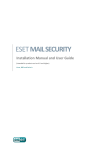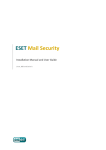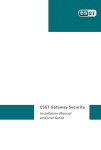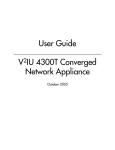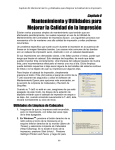Download ESET GATEWAY SECURITY - FOR LINUX BSD AND SOLARIS Installation manual
Transcript
ESET FILE SECURITY
Installation Manual and User Guide
(intended for product version 4.0 and higher)
Linux, BSD and Solaris
Contents
1.
Introduction
..................................................................3
1.1
1.2
Main functionality
.........................................................................................3
Key features
of the system
.........................................................................................3
2.
Terminology
..................................................................5
and abbreviations
3.
System
..................................................................6
requirements
4.
Installation
..................................................................7
5.
Architecture
..................................................................9
Overview
6.
Integration
..................................................................11
with File System services
6.1
6.2
On-demand
scanner
.........................................................................................11
On-access
scanner using preload LIBC library
.........................................................................................11
6.2.1
Operation
...........................................................................11
principle
6.2.2
Installation
...........................................................................12
and configuration
6.2.3
Tips
...........................................................................12
On-access
scanner powered by Dazuko
.........................................................................................12
6.3.1
Operation
...........................................................................12
principle
6.3.2
Installation
...........................................................................13
and configuration
6.3.3
Tips
...........................................................................13
6.3
7.
Important
..................................................................14
ESET File Security mechanisms
7.1
7.2
7.3
7.4
7.5
7.7
7.8
Handle
Object Policy
.........................................................................................14
User.........................................................................................14
Specific Configuration
Samples
Submission System
.........................................................................................15
Scheduler
.........................................................................................15
Web.........................................................................................16
Interface
7.5.1
License
...........................................................................16
management
7.5.2
On-Access
...........................................................................17
scanner (DAC) configuration example
7.5.3
On-Demand
...........................................................................18
scanner
7.5.4
Scheduler
...........................................................................18
7.5.5
Statistics
...........................................................................19
Remote
Administration
.........................................................................................19
7.6.1
Remote
...........................................................................20
Administration usage example
Logging
.........................................................................................22
Command-line
scripts
.........................................................................................22
8.
ESET..................................................................23
Security system update
8.1
8.2
8.3
ESETS.........................................................................................23
update utility
ESETS.........................................................................................23
update process description
ESETS.........................................................................................23
mirror http daemon
9.
Let us
..................................................................24
know
7.6
ESET FILE SECURITY
Copyright ©2013 by ESET, spol. s r. o.
ESET File Security was developed by ESET, spol. s r. o.
For more information visit www.eset.com.
All rights reserved. No part of this documentation may be reproduced,
stored in a retrieval system or transmitted in any form or by any
means, electronic, mechanical, photocopying, recording, scanning, or
otherwise without permission in writing from the author.
ESET, spol. s r. o. reserves the right to change any of the described
application software without prior notice.
Worldwide Customer Support: www.eset.com/support
REV. 7/2/2013
10. Appendix
..................................................................25
A. PHP License
1. Introduction
Thank you for using ESET File Security - the premier security system for Linux, BSD and Solaris. ESET's state-of-the-art scanning
engine has unsurpassed scanning speed and detection rates combined with a very small footprint that makes it the ideal choice
for any server on Linux, BSD and Solaris.
1.1 Main functionality
On-demand scanner
The On-demand scanner can be started by a privileged user (usually a system administrator) through the command line
interface, the web interface or by the operating system's automatic scheduling tool (e.g., cron). The term On-demand refers to file
system objects being scanned by either user or system demand.
On-access scanner
The On-access scanner is invoked whenever a user and/or operating system attempts to access file system objects. This also
clarifies the use of the term On-access; because a scan is triggered by any attempt to access file system objects.
1.2 Key features of the system
Advanced engine algorithms
The ESET antivirus scanning engine algorithms provide the highest detection rate and the fastest scanning times.
Multi-processing
ESET File Security is developed to run on single- as well as multi-processor units.
Advanced Heuristics
ESET File Security includes unique advanced heuristics for Win32 worms, backdoor infections and other forms of malware.
Built-In features
Built-in archivers unpack archived objects without requiring any external programs.
Speed and efficiency
To increase the speed and efficiency of the system, ESET File Security's architecture is based on the running daemon (resident
program) where all scanning requests are sent.
Enhanced security
All executive daemons (except esets_dac) run under a non-privileged user account to enhance security.
Selective configuration
The system supports selective configuration based on the user or client/server.
Multiple logging levels
Multiple logging levels can be configured to get information about system activity and infiltrations.
Web interface
Configuration, administration and license management are offered through an intuitive and user-friendly web interface.
Remote administration
The system supports ESET Remote Administrator for management in large computer networks.
No external libraries
The ESET File Security installation does not require external libraries or programs except for LIBC.
User-specified notification
The system can be configured to notify specific users in the event of a detected infiltration or other important events.
3
Low system requirements
To run efficiently, ESET File Security requires just 250MB of hard-disk space and 256MB of RAM. It runs smoothly under the 2.6.x
Linux OS kernel versions as well as under 5.x, 6.x FreeBSD OS kernel versions.
Performance and scalability
From lower-powered, small office servers to enterprise-class ISP servers with thousands of users, ESET File Security delivers the
performance and scalability you expect from a UNIX based solution, in addition to the unequaled security of ESET security
products.
4
2. Terminology and abbreviations
In this section, we will review the terms and abbreviations used in this document. Note that boldface font is reserved for product
component names and also for newly defined terms and abbreviations. Terms and abbreviations defined in this chapter are
expanded on later in this document.
ESETS
ESET Security is a standard acronym for all security products developed by ESET, spol. s r. o. for Linux, BSD and Solaris operating
systems. It is also the name of the software package containing the products.
ESETS daemon
The main ESETS system control and scanning daemon: esets_daemon.
ESETS base directory
The directory where ESETS loadable modules containing the virus signature database are stored. The abbreviation @BASEDIR@
will be used for future references to this directory. The @BASEDIR@ value (depending on the operating system) is listed below:
Linux: /var/opt/eset/esets/lib
FreeBSD: /var/lib/esets
NetBSD: /var/lib/esets
Solaris: /var/opt/esets/lib
ESETS configuration directory
The directory where all files related to the ESET File Security configuration are stored. The abbreviation @ETCDIR@ will be used
for future references to this directory. The @ETCDIR@ value (depending on the operating system) is listed below:
Linux: /etc/opt/eset/esets
FreeBSD: /usr/local/etc/esets
NetBSD: /usr/pkg/etc/esets
Solaris: /etc/opt/esets
ESETS configuration file
Main ESET File Security configuration file. The absolute path of the file is as follows:
@ETCDIR@/esets.cfg
ESETS binary files directory
The directory where the relevant ESET File Security binary files are stored. The abbreviation @BINDIR@ will be used for future
references to this directory. The @BINDIR@ value (depending on the operating system) is listed below:
Linux: /opt/eset/esets/bin
FreeBSD: /usr/local/bin
NetBSD: /usr/pkg/bin
Solaris: /opt/esets/bin
ESETS system binary files directory
The directory where the relevant ESET File Security system binary files are stored. The abbreviation @SBINDIR@ will be used for
future references to this directory. The @SBINDIR@ value (depending on the operating system) is listed below:
Linux: /opt/eset/esets/sbin
FreeBSD: /usr/local/sbin
NetBSD: /usr/pkg/sbin
Solaris: /opt/esets/sbin
ESETS object files directory
The directory where the relevant ESET File Security object files and libraries are stored. The abbreviation @LIBDIR@ will be used
for future references to this directory. The @LIBDIR@ value (depending on the operating system) is listed below:
Linux: /opt/eset/esets/lib
FreeBSD: /usr/local/lib/esets
NetBSD: /usr/pkg/lib/esets
Solaris: /opt/esets/lib
Note: In a 64-bit Linux operating system environment there are some 32-bit libraries available in the following directory (for
example, the libesets_pac.so preload library to scan 32-bit binary files):
Linux: /opt/eset/esets/lib32
5
3. System requirements
The following hardware requirements must be met before the installation process in order to run ESET File Security properly:
250MB of hard-disk space
256MB of RAM
glibc 2.3.6 or higher
2.6.x Linux OS kernel versions
ESET File Security should work on most recent and frequently used open-source Linux distributions if the above criteria are met.
The following Linux distributions (x86/x64) are officially supported:
Red Hat Enterprise Linux
SUSE Linux Enterprise
ESET File Security will also run on the following operating systems (but only x86, 32-bit):
NetBSD 4
FreeBSD 6, 7, 8 and 9
SUN Solaris 10
6
4. Installation
After purchasing ESET File Security, you will receive your authorization data (Username, Password and license key). These
credentials identify you as an ESET customer, and are required to download updates for ESET File Security. The Username/
Password data is also required for downloading the initial installation package from our web site. ESET File Security is
distributed as a binary file:
esets.arch.ext.bin
In the binary file shown above, ‘ext’ is a Linux, BSD and Solaris OS distribution dependent suffix, i.e., ‘deb’ for Debian, ‘rpm’ for
RedHat and SuSE, ‘tgz’ for other Linux OS distributions, ‘fbs7.tgz’ for FreeBSD 7.x, ‘fbs8.tgz’ for FreeBSD 8.x, ‘nbs4.tgz’ for NetBSD
4.xx and ‘sol10.pkg.gz‘ for Solaris 10.
The ‘arch’ value represents a computer architecture, either ‘i386’ for 32-bit OS distributions or ‘amd64’, ‘x86_64’ for 64-bit.
To install or upgrade your product, run the ESET distribution script appropriate for the OS distribution and architecture that you
have:
sh
sh
sh
sh
./esets.i386.deb.bin
./esets.i386.fbs8.tgz.bin
./esets.amd64.deb.bin
./esets.x86_64.rpm.bin
Once you accept the product License Agreement, you will be prompted to enable or disable the Samples submission system
during the installation.
Figure 4-1. Installation of ESET File Security via Terminal.
An installation package esets-version.arch.ext will be created and placed in the current working directory. Information regarding
the installation, uninstallation or upgrade will be displayed onscreen.
To complete the installation or upgrade of your product, run the newly created esets-version.arch.ext file using the appropriate
syntax for your OS distribution:
Linux OS:
dpkg –i esets-4.0.x.i386.deb
rpm –U esets-4.0.x.i386.rpm
BSD OS:
pkg_add esets-4.0.x.i386.fbs8.tgz
Solaris:
gunzip esets-4.0.x.i386.sol10.pkg.gz
pkgadd –d esets-4.0.x.i386.sol10.pkg
Note: The procedure with an installation package esets-version.arch.ext is available only for versions 4.0.8 and below. Enabling
or disabling the Samples submission system is available from version 4.0.10.
Import the license files:
@SBINDIR@/esets_lic --import file.lic
7
Enter your Username and Password information into the global section of the ESET configuration file using a text editor:
vi @ETCDIR@/esets.cfg
Edit the ESETS Update options section of the ESETS configuration file.
av_update_username = "EAV-12345678"
av_update_password = "yourpassword"
Start main daemon service:
Linux OS:
BSD OS:
/etc/init.d/esets start
/usr/local/etc/rc.d/esets.sh start
Once the package is installed, you can verify that the main ESETS service is running by using the following command:
Linux OS:
BSD OS:
Solaris:
ps -C esets_daemon
ps -ax | grep esets_daemon
ps -A | grep esets_daemon
After pressing ENTER, you should see the following (or similar) message:
PID TTY
2226 ?
2229 ?
TIME CMD
00:00:00 esets_daemon
00:00:00 esets_daemon
At least two ESETS daemon processes are running in the background. The first PID represents the process and threads manager of
the system. The other represents the ESETS scanning process.
To help you easily integrate ESET Security with your system, you can also use the ESET Security interactive automated install
script. Note that automated installation is not available for File Servers. For more information, see the guide in /opt/eset/esets/
share/doc for general instructions. You can undo all changes later. A list of available ESETS installations/uninstallations
according to imported licenses will be displayed.
@SBINDIR@/esets_setup
8
5. Architecture Overview
Once ESET File Security is successfully installed, you should become familiar with its architecture.
Figure 4-1. Structure of ESET File Security.
The structure of ESET File Security is shown in Figure 4-1. The system is comprised of the following parts:
CORE
The core of ESET File Security is the ESETS daemon (esets_daemon). The daemon uses ESETS API library libesets.so and ESETS
loading modules em00X_xx.dat to provide base system tasks such as scanning, maintenance of the agent daemon processes,
maintenance of the samples submission system, logging, notification, etc. Please refer to the esets_daemon(8) man page for
details.
AGENTS
The purpose of ESETS agent modules is to integrate ESETS with the Linux, BSD and Solaris server environment.
UTILITIES
The utility modules provide simple and effective system management. They are responsible for system tasks such as license
management, quarantine management, system setup and update.
CONFIGURATION
Proper configuration is the most important aspect of your security system; the remainder of this chapter is dedicated to
explaining all related components. A thorough understanding of the esets.cfg file is also highly recommended, as this file
contains information essential to the configuration of ESET File Security.
After the product is successfully installed, all its configuration components are stored in the ESETS configuration directory. The
directory consists of the following files:
@ETCDIR@/esets.cfg
This is the most important configuration file, as it controls all major aspects of the product’s functionality. The esets.cfg file is
made up of several sections, each of which contains various parameters. The file contains one global and several “agent“
sections, with all section names enclosed in square brackets. Parameters in the global section are used to define configuration
options for the ESETS daemon as well as default values for the ESETS scanning engine configuration. Parameters in agent sections
are used to define configuration options of modules used to intercept various data flow types in the computer and/or its
neighborhood, and prepare it for scanning. Note that in addition to the various parameters used for system configuration, there
are also rules governing the organization of the file. For detailed information on the most effective way to organize this file,
please refer to the esets.cfg(5) and esets_daemon(8) man pages, as well as relevant agents' man page.
@ETCDIR@/certs
This directory is used to store the certificates used by the ESETS web interface for authentication. Please see the esets_wwwi(8)
man page for details.
9
@ETCDIR@/license
This directory is used to store the product(s) license key(s) you have acquired from your vendor. Note that the ESETS daemon will
check only this directory for a valid license key.
@ETCDIR@/scripts/license_warning_script
If enabled by the Scheduler task named Threat notification, this script will be executed 30 days (once per day) before product
license expiration, sending an email notification about the expiration status to the system administrator.
@ETCDIR@/scripts/daemon_notification_script
If enabled by the Scheduler task named License expiration, this script is executed in the event of a detected infiltration by the
antivirus system. It is used to send email notification about the event to the system administrator.
10
6. Integration with File System services
This chapter describes the On-demand and On-access scanner configuration which will provide the most effective protection
from virus and worm file system infections. ESET File Security’s scanning power is derived from the On-demand scanner
command ‘esets_scan’ and the On-access scanner command ‘esets_dac’. The Linux version of ESET File Security offers an
additional On-access scanner technique which uses the preloaded library module libesets_pac.so. All of these commands are
described in the following sections.
6.1 On-demand scanner
The On-demand scanner can be started by a privileged user (usually a system administrator) through the command line
interface, web interface or by the operating system’s automatic scheduling tool (e.g., cron). The term On-demand refers to file
system objects which are scanned on user or system demand.
The On-demand scanner does not require special configuration in order to run. After the ESETS package has been properly
installed and a valid license has been moved to the license keys directory (@ETCDIR@/license), the On-demand scanner can be
run immediately using the command line interface or the Scheduler tool. To run the On-demand scanner from the command line,
use the following syntax:
@SBINDIR@/esets_scan [option(s)] FILES
where FILES is a list of directories and/or files to be scanned.
Multiple command line options are available using ESETS On-demand scanner. To see the full list of options, please see the
esets_scan(8) man page.
6.2 On-access scanner using preload LIBC library
The On-access scanner is invoked by user(s) access and/or operating system access to file system objects. This also explains the
term On-access; the scanner is triggered on any attempt to access a selected file system object.
In the following sections, we will also describe the integration of the On-access scanner powered by Dazuko with Linux/BSD file
system services. Using Dazuko may not be feasible in all situations, including system administrators who maintain critical
systems where:
the source code and/or configuration files related to the running kernel are not available,
the kernel is more monolithic than modular,
the Dazuko module simply does not support the given OS.
In any of these cases, the On-access scanning technique based on the preload LIBC library should be used. See the following
topics in this section for detailed information. Please note that this section is relevant only for Linux OS users and contains
information regarding the operation, installation and configuration of the On-access scanner using the preload library
‘libesets_pac.so’.
6.2.1
Operation principle
The On-access scanner libesets_pac.so (ESETS Preload library based file Access Controller) is a shared objects library which is
activated at system start up. This library is used for LIBC calls by file system servers such as FTP server, Samba server etc. Every
file system object is scanned based on customizable file access event types. The following event types are supported by the
current version:
Open events
This file access type is activated if the word ‘open’ is present in the ‘event_mask’ parameter in the esest.cfg file ([pac] section).
Create (close) events
This file access type is activated if the word ‘create’ is present in the ‘event_mask’ parameter in the esets.cfg file ([pac] section). In
this case, all file descriptor and FILE stream create/close functions of the LIBC are intercepted.
Exec events
This file access type is activated if the word ‘exec’ is present in the ‘event_mask’ parameter in the esets.cfg ([pac] section). In this
case, all exec functions of the LIBC are intercepted.
All opened, closed and executed files are scanned by the ESETS daemon for viruses. Based on the result of such scans, access to
given files is denied or allowed.
11
6.2.2
Installation and configuration
The libesets_pac.so library module is installed using a standard installation mechanism of the preloaded libraries. You need to
define the environment variable ‘LD_PRELOAD’ with the absolute path to the libesets_pac.so library. For more information, please
refer to the ld.so(8) man page.
Note: It is important that the ‘LD_PRELOAD‘ environment variable is defined only for the network server daemon processes (ftp,
Samba, etc.) that will be under control of the On-access scanner. Generally, preloading LIBC calls for all operating system
processes is not recommended, as this can dramatically slow the performance of the system or even cause the system to hang. In
this sense, the ‘/etc/ld.so.preload’ file should not be used, nor should the ‘LD_PRELOAD‘ environment variable be exported
globally. Both would override all relevant LIBC calls, which could lead to system hang ups during initialization.
To ensure that only relevant file access calls within a given file system are intercepted, executable statements can be overridden
using the following line:
LD_PRELOAD=@LIBDIR@/libesets_pac.so COMMAND COMMAND-ARGUMENTS
where ‘COMMAND COMMAND-ARGUMENTS’ is the original executable statement.
Review and edit the [global] and [pac] sections of the ESETS configuration file (esets.cfg). In order for the On-access scanner to
function correctly, you must define the file system objects (i.e. directories and files) that are required to be under control of the
preload library. This can be achieved by defining the parameters of the ‘ctl_incl’ and ‘ctl_excl’ options in the [pac] section of the
ESETS configuration file. After making changes to the esets.cfg file, you can force the newly created configuration to be re-read by
reloading the ESETS daemon.
6.2.3
Tips
In order to activate the On-access scanner immediately after file system start up, the ‘LD_PRELOAD’ environment variable must
be defined within the appropriate network file server initialization script.
Example: Let’s assume we want to have the On-access scanner to monitor all file system access events immediately after starting
the Samba server. Within the Samba daemon initialization script (/etc/init.d/smb), we would replace the statement
daemon /usr/sbin/smbd $SMBDOPTIONS
with the following line:
LD_PRELOAD=@LIBDIR@/libesets_pac.so daemon /usr/sbin/smbd $SMBDOPTIONS
In this way, selected file system objects controlled by Samba will be scanned at system start-up.
6.3 On-access scanner powered by Dazuko
The technique used by ESETS On-access scanner can be also powered by the Dazuko (da-tzu-ko) kernel module and is based on
the interception of kernel calls. The Dazuko project is open source, which means that its source code is freely distributed. This
allows users to compile the kernel module for their own custom kernels. Note that the Dazuko kernel module is not a part of any
ESETS product and must be compiled and installed into the kernel prior to using the On-access command esets_dac. The Dazuko
technique makes On-access scanning independent from the file system type used. It is also suitable for scanning of file system
objects via Network File System (NFS), Nettalk and Samba.
Important: Before we provide detailed information related to On-access scanner configuration and use, it should be noted that
the scanner has been primarily developed and tested to protect externally mounted file systems. If there are multiple file systems
that are not externally mounted, you will need to exclude them from file access control in order to prevent system hang ups. An
example of a typical directory to exclude is the ‘/dev’ directory and any directories used by ESETS.
6.3.1
Operation principle
The On-access scanner esets_dac (ESETS Dazuko-powered file Access Controller) is a resident program which provides
continuous monitoring and control over the file system. Every file system object is scanned based on customizable file access
event types. The following event types are supported by the current version:
Open events
To activate this file access type, set the value of the ‘event_mask’ parameter to open in the [dac] section of the esets.cfg file. This
will enable the ON_OPEN bit of the Dazuko access mask.
Create (close) events
To activate this file access type, set the value of the ‘event_mask’ parameter to close in the [dac] section of the esets.cfg file. This
will enable the ON_OPEN bit of the Dazuko access mask. This will enable the ON_CLOSE and ON_CLOSE_MODIFIED bits of the
Dazuko access mask.
12
Note: Some OS kernel versions do not support the interception of ON_CLOSE events. In these cases, close events will not be
monitored by esets_dac.
Exec events
To activate this file access type, set the value of the ‘event_mask’ parameter to exec in the [dac] section of the esets.cfg file. This
will enable the ON_EXEC bit of the Dazuko access mask.
The On-access scanner ensures that all opened, closed and executed files are first scanned by the esets_daemon for viruses.
Depending on the scan results, access to specific files is denied or allowed.
6.3.2
Installation and configuration
The Dazuko kernel module must be compiled and installed within the running kernel before initializing esets_dac. For details on
how to compile and install Dazuko, please see:
http://www.dazuko.org
Once Dazuko is installed, review and edit the [global] and [dac] sections of the ESETS configuration file (esets.cfg). Note that for
the On-access scanner properly function, it is dependent upon configuration of the ‘agent_enabled’ option within the [dac]
section of this file. Additionally, you must define the file system objects (i.e. directories and files) that are to be monitored by the
On-access scanner. This can be accomplished by defining the parameters of the ‘ctl_incl’ and ‘ctl_excl’ options, which are also
located within the [dac] section. After making changes to the esets.cfg file, you can force the newly created configuration to be reread by reloading the ESETS daemon.
6.3.3
Tips
To ensure that the Dazuko module loads prior to initialization of the esets_dac daemon, follow these steps:
Place a copy of the Dazuko module in either of the following directories reserved for kernel modules:
/lib/modules
or
/modules
Use the kernel utilities ‘depmod’ and ‘modprobe’ (For BSD OS, use ‘kldconfig’ and ‘kldload’) to handle dependencies and
successfully initialize the newly added Dazuko module.
In the esets_daemon initialization script ‘/etc/init.d/esets_daemon’, insert the following line before the daemon initialization
statement:
/sbin/modprobe dazuko
For BSD OS’s the line
/sbin/kldconfig dazuko
must be inserted into the ‘/usr/local/etc/rc.d/esets_daemon.sh’ script.
Warning! It is extremely important that these steps are executed in the exact order given. If the kernel module is not located
within the kernel modules directory it will not properly load, causing the system to hang.
13
7. Important ESET File Security mechanisms
7.1 Handle Object Policy
The Handle Object Policy (see figure 6-1) mechanism provides filtering for scanned objects based on their status. This
functionality is based on the following configuration options:
action_av
action_av_infected
action_av_notscanned
action_av_deleted
For detailed information on these options, please refer to the esets.cfg(5) man page.
Figure 6-1. Scheme of Handle Object Policy mechanism.
Every processed object is first handled according to the configuration of the ‘action_av‘ option. If this option is set to ‘accept’ (or
‘defer’, ‘discard’, ‘reject’) the object is accepted (or deferred, discarded, rejected). If the option is set to ‘scan’ the object is scanned
for virus infiltrations, and if the ‘av_clean_mode’ option is set to ‘yes’, the object is also cleaned. In addition, the configuration
options ‘action_av_infected’, ‘action_av_notscanned’ and ‘action_av_deleted’ are taken into account to further evaluate object
handling. If an ‘accept’ action has been taken as a result of these three action options, the object is accepted. Otherwise, the
object is blocked.
7.2 User Specific Configuration
The purpose of the User Specific Configuration mechanism is to provide a higher degree of customization and functionality. It
allows the system administrator to define ESETS antivirus scanner parameters based on the user who is accessing file system
objects.
A detailed description of this functionality can be found in the esets.cfg(5) man page. In this section we will provide only a short
example of a user-specific configuration.
In this example, the goal is to use the esets_dac module to control the ON_OPEN and ON_EXEC access events for an external disc
mounted under the /home directory. The module can be configured in the [dac] section of the ESETS configuration file. See below:
[dac]
agent_enabled = yes
event_mask = "open"
ctl_incl = "/home"
action_av = "scan"
To specify scan settings for an individual user, the ‘user_config’ parameter must specify the special configuration filename where
the individual scanning rules will be stored. In the example shown here, the special configuration file is called
‘esets_dac_spec.cfg’ and is located within the ESETS configuration directory (This directory is based on your operating system.
Please see Terminology and abbreviations page).
14
[dac]
agent_enabled = yes
event_mask = "open"
ctl_incl = "/home"
action_av = "scan"
user_config = "esets_dac_spec.cfg"
Once the ‘user_config’ file parameter is specified within the [dac] section, the ‘esets_dac_spec.cfg’ file must be created in the ESETS
configuration directory. Finally, add the desired scanning rules.
[username]
action_av = "reject"
At the top of the special section, enter the username to which the individual rules will be applied. This configuration will allow
all other users attempting to access the file-system to be processed normally. i.e., all file system objects accessed by other users
will be scanned for infiltrations, except for the user ‘username’, whose access will be rejected (blocked).
7.3 Samples Submission System
The Samples submission system is an intelligent ThreatSense.Net technology that collects infected objects that have been
detected by advanced heuristics and delivers them to the samples submission system server. All virus samples collected by the
sample submission system will be processed by the ESET virus laboratory and if necessary, added to the ESET virus signature
database.
Note: According to our license agreement, by enabling the sample submission system you are agreeing to allow the computer
and/or platform on which the esets_daemon is installed to collect data (which may include personal information about you
and/or other users of the computer) and samples of newly detected viruses or other threats and send them to ESET virus
laboratory. This feature is disabled by default. All information collected will be used only to analyze new threats and will not be
used for any other purpose.
In order to enable sampling, the samples submission system cache must be initialized. This can be achieved by selecting
‘samples_enabled’ in the [global] section of the ESETS configuration file.
For more information on the Samples Submission System and its options, please refer to the esets_daemon(8) mane page.
7.4 Scheduler
The Scheduler's functionality includes running scheduled tasks at a specified time or on a specific event, managing and
launching tasks with predefined configuration and properties and more. Task configuration and properties can be used to
influence launch dates and times, but also to expand the application of tasks by introducing the use of custom profiles during
task execution.
The ‘scheduler_tasks’ option is commented by default, causing the default scheduler configuration to be applied. In the ESETS
configuration file all parameters and tasks are semicolon-separated. Any other semicolons (and backslashes) must be
backslash escaped. Each task has 6 parameters and the syntax is as follows:
id – Unique number.
name – Task description.
flags – Special flags to disable the specified scheduler task can be set here.
failstart – Instructs what to do if task could not be run on scheduled date.
datespec – A regular date specification with 6 (crontab like year-extended) fields, recurrent date or an event name option.
command – Can be an absolute path to a command followed by its arguments or a special command name with the ‘@’ prefix
(e.g. anti-virus update: @update).
#scheduler_tasks = "id;name;flags;failstart;datespec;command;id2;name2;...";
The following event names can be used in place of the datespec option:
start – Daemon startup.
startonce – Daemon startup but at most once a day.
engine – Successful engine update.
login – Web interface logon startup.
threat – Threat detected.
notscanned – Not scanned email or file.
licexp – 30 days before license expiration.
To display the current scheduler configuration, use the Web interface or run the following command:
cat @ETCDIR@/esets.cfg | grep scheduler_tasks
For a full description of Scheduler and its parameters refer to the Scheduler section of the esets_daemon(8) man page.
15
7.5 Web Interface
The web interface allows user-friendly configuration, administration and license management of ESET Security systems. This
module is a separate agent and must be explicitly enabled. To quickly configure the Web Interface, set the following options in
the ESETS configuration file and restart the ESETS daemon:
[wwwi]
agent_enabled = yes
listen_addr = address
listen_port = port
username = name
password = pass
Replace the text in italics with your own values and direct your browser to ‘https://address:port’ (note the https). Login with
‘username/password’. Basic usage instructions can be found on the help page and technical details about esets_wwwi can be
found on the esets_wwwi(1) man page.
The web interface allows you to remotely access the ESETS daemon and deploy it easily. This powerful utility makes it easy to
read and write configuration values.
Figure 6-1. ESET Security for Linux - Home screen.
The web interface window of ESET File Security is divided into two main sections. The primary window, that serves to display the
contents of the selected menu option and the main menu. This horizontal bar on the top lets you navigate between the following
main options:
Home – provides basic system and ESET product information
Licenses – is a license management utility, see the following chapter for mode details
Configuration – you can change the ESET File Security system configuration here
Control – allows you to run simple tasks and view global statistics about objects processed by esets_daemon
Help – provides detailed usage instructions for the ESET File Security web interface
Logout – use to end your current session
Important: Make sure you click the Save changes button after making any changes in the Configuration section of the web
interface to save your new settings. To apply your settings you will need to restart the ESETS daemon by clicking Apply changes on
the left pane.
7.5.1
License management
You can upload a new license using the web interface, as shown in Figure 6-2.
If you want to display licenses in the console, use the following command:
@SBINDIR@/esets_lic --list
If you want to import new license files, use the following command:
@SBINDIR@/esets_lic --import *.lic
16
Figure 6-2. ESET Licenses.
You can enable the license notification option in the Scheduler section options. If enabled, this functionality will notify you 30
days prior to your license expiration.
7.5.2
On-Access scanner (DAC) configuration example
There are two ways you can to configure ESETS. In our example, we will demonstrate how to use either of them to setup the DAC
module, described in the On-access scanner powered by Dazuko chapter. You can choose the option that best suits you.
Using the ESETS configuration file:
[dac]
agent_enabled = yes
event_mask = "open"
ctl_incl = "/home"
action_av_deleted = "reject"
action_av = "scan"
action_av_infected = "reject"
Using the web interface:
Figure 6-3. ESETS - Configuration > On-Access scanner.
When changing settings in the web interface, always remember to save your configuration by clicking Save changes. To apply
17
your new changes, click the Apply changes button in the Configuration sections panel.
7.5.3
On-Demand scanner
This section comprises an example on how to run the On-Demand scanner to scan for viruses:
Navigate to Control > On-Demand Scan
Enter the path to the directory you want to scan
Execute the command-line scanner by clicking the Scan button
Figure 6-4. ESETS - Control > On-Demand scanner.
ESET Command-line scanner will automatically run in the background. To see the scanning progress, click the View link. A new
browser window will open.
7.5.4
Scheduler
You can manage the scheduler tasks either via ESET configuration file (see chapter Scheduler) or using the web interface.
Figure 6-5. ESETS - Global > Scheduler.
18
Click the checkbox to enable/disable a scheduled task. By default, the following scheduled tasks are displayed:
Log maintenance – The program automatically deletes older logs in order to save hard disk space. The Scheduler will start
defragmenting logs. All empty log entries will be removed during this process. This will improve the speed when working with
logs. The improvement will be more noticeable if the logs contain a large number of entries.
Automatic startup file check – Scans memory and running services after a successful update of the virus signature database.
Regular automatic update – Regularly updating ESET File Security is the best method of keeping the maximum level of security on
your computer. See ESETS update utility for more information.
Regular update of AntiSpam modules – The period after which ESETS will check for available antispam module updates. If you do
not set this scheduled task, ESETS will not regularly update its antispam database.
Note: For this option to be available you must have a valid license for ESET Mail Security.
Threat notification – By default, each threat will be logged into syslog. In addition, ESETS can be configured to run an external
(notification) script to notify a system administrator via email about threat detection.
License expiration – If enabled, this functionality will notify you 30 days prior to your license expiration. This task will run the
@ETCDIR@/scripts/license_warning_script shell script, which sends an email to the email address of the root user account. The
script can be customized to reflect specific server needs.
7.5.5
Statistics
You can view statistics for all of active ESETS agents here. The Statistics summary refreshes every 10 seconds.
Figure 6-6. ESETS - Control > Statistics.
7.6 Remote Administration
ESETS supports ESET Remote Administration for file security management in large computer networks. The ESETS Remote
Administration Client is part of the main ESETS daemon and performs the following functions:
Communicates with ERA Server and provides you with system information, configuration, protection statuses and several
other features
Allows client configurations to be viewed/modified using the ESET Configuration Editor and implemented with the help of
configuration tasks
Can perform Update Now tasks
Performs On-demand scans as requested, and submits the results back to ERA Server Scan Log
Adds logs of notable scans performed by the ESETS daemon to Threat Log
Sends all non-debug messages to Event Log
These functionalities are not supported:
Firewall Log
Remote Install
19
Figure 6-7. ERA Console tabs.
For more information, please read the ESET Remote Administrator manual. This manual is located on our web site at the
following link:
http://www.eset.com/documentation
7.6.1
Remote Administration usage example
Before commencing any remote administration process, ensure your system fulfills the three following prerequisites:
Running ERA Server
Running ERA Console
Enable RA Client in the ESETS daemon. Ensure that firewall settings do not block traffic to ERA Server or vice versa.
To setup the basics, specify the address of your ERA Server in the ‘racl_server_addr’ parameter first. If you are using a password to
access the ERA Console password, you must edit the value of the ‘racl_password’ parameter accordingly. Change the value of the
‘racl_interval’ parameter to adjust the frequency of connections to ERA Server (in minutes).
You can either use the web interface (see also previous chapter) to apply the new configuration, or you can adjust these
parameters in the [global] section of the ESETS configuration file as follows:
racl_server_addr = "yourServerAddress"
racl_server_port = 2222
racl_password = "yourPassword"
racl_interval = 1
Note: All applicable ESET Remote Administration Client variables are listed on the esets_daemon(8) man page.
The ESETS daemon configuration will be reloaded and RACL will connect to ERA Server. You will be able to see a newly connected
client in your ERA Console. Press the F5 button (or Menu > View > Refresh) to manually refresh the list of connected clients.
Figure 6-8. ERA Console.
By using ERA Console you can create a configuration task to ESETS daemon from ERA Console:
Right-click the connected Client Name
Navigate to New Task > Configuration Task > Create...
Expand the Unix ESET Security tree
For an example of a configuration task by the DAC agent, see below:
20
Figure 6-8. ERA Configuration Editor.
The New Task context menu contains On-demand scanning options (enabled/disabled cleaning).
You can select the desired product that you wish to set the task for in the On-Demand Scan pop-up window in the Configuration
Section drop-down menu. Make sure that you select the On-demand Scan task for Unix ESET Security Product option (i.e. the
product that is installed on your target workstation).
Figure 6-9. ERA On-demand scan.
21
7.7 Logging
ESETS provides system daemon logging via syslog. Syslog is a standard for logging program messages and can be used to log
system events such as network and security events.
Messages refer to a facility:
auth, authpriv, daemon, cron, ftp, lpr, kern, mail, ..., local0, ..., local7
Messages are assigned a priority/level by the sender of the message:
Error, Warning, Summall, Summ, Partall, Part, Info, Debug
This section describes how to configure and read the logging output of syslog. The ‘syslog_facility’ option (default value ‘daemon’)
defines the syslog facility used for logging. To modify syslog settings edit the ESETS configuration file or use the Web interface.
Modify the value of the ‘syslog_class’ parameter to change the logging class. We recommend you modify these settings only if you
are familiar with syslog. For an example syslog configuration, see below:
syslog_facility = "daemon"
syslog_class = "error:warning:summall"
The name and location of the log file depend on your syslog installation and configuration (e.g. rsyslog, syslog-ng, etc.). Standard
filenames for syslog output files are for example ‘syslog’, 'daemon.log', etc. To follow syslog activity, run one of the following
commands from the console:
tail -f /var/log/syslog
tail -100 /var/log/syslog | less
cat /var/log/syslog | grep esets | less
If you enable ESET Remote Administration, ERA log entries older than given days by the option ‘racl_logs_lifetime’ will be
automatically deleted.
7.8 Command-line scripts
ESETS commands can be launched using the command line – manually (@SBINDIR@/esets_*) or with a batch (".sh") script. ESETS
command-line usage:
esets_daemon
ESET Security Daemon is the main ESET’S system control and scanning Daemon module. It reads all the
ESET’S scanner configuration from the main ESET’S configuration file and provides all the main tasks.
Usage: @SBINDIR@/esets_daemon [OPTIONS..]
esets_inst
ESET system integrator can be used to display and optionally execute commands that integrate ESET’S
with your system.
Usage: @SBINDIR@/esets_inst [OPTIONS..] [COMMAND]
esets_lic
ESET’S license management utility features management options, which allow you to display
information about your licenses, import license files to the license directory or remove expired
licenses.
Usage: @SBINDIR@/esets_lic [OPTIONS..] [COMMAND] [FILES..]
esets_quar
ESET‘S quarantine management utility module allows you to import any file system object into the
quarantine storage area.
Usage: @SBINDIR@/esets_quar ACTIONS [RULES] [OBJECTS..]
esets_scan
ESET Command-line scanner is an on-demand anti-virus scanning module, which provides scanning of
the file system objects upon user request using command line interface.
Usage: @SBINDIR@/esets_scan [OPTIONS..] FILES..
esets_set
ESETS configuration file SET-up utility allows you to modify the ESET’S configuration file as requested by
given command.
Usage: @SBINDIR@/esets_set [OPTIONS..] [COMMAND]
esets_setup
ESET’S setup utility is an interactive automated install script to help you easily integrate ESET Security
with your system.
Usage: @SBINDIR@/esets_setup [OPTIONS..] [COMMAND]
esets_update
ESET‘S update utility is a system utility for the creation, update and maintenance of the ESET’S modules
storage mirrors as well as for update of ESET’S system.
Usage: @BINDIR@/esets_update [OPTIONS..]
22
8. ESET Security system update
8.1 ESETS update utility
To maintain the effectiveness of ESET File Security, the virus signature database must be kept up to date. The esets_update utility
has been developed specifically for this purpose. See the esets_update(8) man page for details. To launch an update, the
configuration options ‘av_update_username’ and ‘av_update_password’ must be defined in the [global] section of the ESETS
configuration file. In the event that your server accesses the Internet via HTTP proxy, the additional configuration options
‘proxy_addr’, ‘proxy_port’ must be defined. If access to the HTTP proxy requires a username and password, the ‘proxy_username’
and ‘proxy_password’ options must also be defined in this section. To initiate an update, enter the following command:
@SBINDIR@/esets_update
To provide the highest possible security for the end user, the ESET team continuously collects virus definitions from all over the
world - new patterns are added to the virus signature database in very short intervals. For this reason, we recommend that
updates be initiated on a regular basis. To be able to specify the frequency of updates, you need to configure the ‘@update’ task
in the ‘scheduler_tasks’ option in the [global] section of the ESETS configuration file. You can also use the Scheduler to set the
update frequency. The ESETS daemon must be up and running in order to successfully update the virus signature database.
8.2 ESETS update process description
The update process consists of two stages: First, the precompiled update modules are downloaded from the ESET server. If
‘av_mirror_enabled’ is set to yes in the [global] section of the ESETS configuration file, copies (or mirrors) of these update
modules are created in the following directory:
@BASEDIR@/mirror
‘av_mirror_pcu’ allows you to download Program Component Update (PCU) modules for Windows-based ESET security products.
These modules can be mirrored from the ESET server.
Note: To enable the mirror and download PCUs for ESET NOD32 Antivirus, ESET Smart Security, ESET Endpoint Antivirus or ESET
Endpoint Security, you have to:
set your Username and Password for update purposes (as described in the topic above),
import a license for your specific ESET product.
The second stage of the update process is the compilation of modules loadable by the ESET File Security scanner from those
stored in the local mirror. Typically, the following ESETS loading modules are created: loader module (em000.dat), scanner
module (em001.dat), virus signature database module (em002.dat), archives support module (em003.dat), advanced heuristics
module (em004.dat), etc. The modules are created in the following directory:
@BASEDIR@
This is the directory where the ESETS daemon loads modules from and thus can be redefined using the ‘base_dir’ option in the
[global] section of the ESETS configuration file.
8.3 ESETS mirror http daemon
The http mirror daemon in ESET File Security allows you to create copies of update files which can be used to update other
workstations located in the network. Creation of the "mirror" – a copy of the update files in the LAN environment is convenient,
since the update files need not be downloaded from the vendor update server repeatedly and by each workstation. They are
downloaded centrally to the local mirror server and then distributed to all workstations, therefore avoiding the potential risk of
network traffic overload. This is also a typical feature of ESET Remote Administrator.
The http mirror daemon needs to be properly configured to start and enable the mirror. In the example below esets_mird is
configured to listen on port 2221 of a computer with the local network IP address 192.168.1.10. The following parameters in the
[mird] section of the ESETS configuration file need to be specified:
agent_enabled = yes
listen_addr = "192.168.1.10"
listen_port = 2221
Options ‘listen_port’ and ‘listen_addr’ define the port (default 2221) and address (default: all local tcp addresses) where the http
server listens. If you set the value of the ‘auth_mode’ switch from 'none' to 'basic', the mirror will require authentication. The
options ‘username’ and ‘password’ allow the administrator to define the login and password required to access the Mirror.
23
9. Let us know
We hope this guide has provided you with a thorough understanding of the requirements for ESET File Security installation,
configuration and maintenance. It is our goal to continually improve the quality and effectiveness of our documentation.
For additional assistance with your ESET product, please visit our online Knowledgebase at the following URL:
http://kb.eset.com
If you feel that any sections in this guide are unclear or incomplete or you are unable to resolve your issue, please let us know by
using the support form directly:
http://www.eset.com/support/contact
We are dedicated to provide the highest level of support and look forward to helping you should you experience any problems
concerning this product.
24
10. Appendix A. PHP License
The PHP License, version 3.01 Copyright (c) 1999 - 2006 The PHP Group. All rights reserved.
Redistribution and use in source and binary forms, with or without modification, is permitted provided that the following
conditions are met:
1. Redistributions of source code must retain the above copyright notice, this list of conditions and the following disclaimer.
2. Redistributions in binary form must reproduce the above copyright notice, this list of conditions and the following disclaimer
in the documentation and/or other materials provided with the distribution.
3. The name “PHP” must not be used to endorse or promote products derived from this software without prior written
permission. For written permission, please contact [email protected].
4. Products derived from this software may not be called “PHP”, nor may “PHP” appear in their name, without prior written
permission from [email protected]. You may indicate that your software works in conjunction with PHP by saying “Foo for PHP”
instead of calling it “PHP Foo” or “phpfoo”
5. The PHP Group may publish revised and/or new versions of the license from time to time. Each version will be given a
distinguishing version number. Once covered code has been published under a particular version of the license, you may
always continue to use it under the terms of that version. You may also choose to use such covered code under the terms of
any subsequent version of the license published by the PHP Group. No one other than the PHP Group has the right to modify
the terms applicable to covered code created under this License.
6. Redistributions of any form whatsoever must retain the following acknowledgment: “This product includes PHP software,
freely available from <http://www.php.net/software/>”.
THIS SOFTWARE IS PROVIDED BY THE PHP DEVELOPMENT TEAM "AS IS" AND ANY EXPRESSED OR IMPLIED WARRANTIES, INCLUDING,
BUT NOT LIMITED TO, THE IMPLIED WARRANTIES OF MERCHANTABILITY AND FITNESS FOR A PARTICULAR PURPOSE ARE DISCLAIMED.
IN NO EVENT SHALL THE PHP DEVELOPMENT TEAM OR ITS CONTRIBUTORS BE LIABLE FOR ANY DIRECT, INDIRECT, INCIDENTAL,
SPECIAL, EXEMPLARY, OR CONSEQUENTIAL DAMAGES (INCLUDING, BUT NOT LIMITED TO, PROCUREMENT OF SUBSTITUTE GOODS OR
SERVICES; LOSS OF USE, DATA, OR PROFITS; OR BUSINESS INTERRUPTION) HOWEVER CAUSED AND ON ANY THEORY OF LIABILITY,
WHETHER IN CONTRACT, STRICT LIABILITY, OR TORT (INCLUDING NEGLIGENCE OR OTHERWISE) ARISING IN ANY WAY OUT OF THE USE
OF THIS SOFTWARE, EVEN IF ADVISED OF THE POSSIBILITY OF SUCH DAMAGE.
25


























